Kiev (brand)
Kiev is a Soviet and Ukrainian brand of photographic equipment including cameras manufactured by the Arsenal Factory in Kyiv, Ukraine. The camera nameplates show the name "KIEV", with older cameras using "КИЕВ" (in Russian language) or "КИЇВ" (in Ukrainian language)[1] in Cyrillic.
At the end of November 2009 Gevorg Vartanyan of Arax, a Ukrainian distributor of reworked medium format Kiev cameras and lenses, wrote to tell customers that the Arsenal factory was closing after 245 years of operation. The email said that management had been turned over to the Special Construction Department (SKTB), all work had stopped and the workers laid off, and that the factory warehouse was empty. He thought that Arax had enough cameras and parts to remain in business for at least another 4–5 years.[2] The amount of stock remaining with other distributors around the world is unknown.
Kiev 35mm rangefinders
Arsenal produced several 35mm film rangefinders which were clones of the pre-WWII Contax II and Contax III cameras.
Kiev rangefinders retained the same lens mount as the pre-WWII Contax rangefinders, so the lenses can be interchanged between Kiev and Contax rangefinders. The lens mount of those cameras is pretty sophisticated compared with other cameras of the time. The so-called Contax/Kiev bayonet actually consists of two bayonets - the inner bayonet, which is used exclusively for 50mm lenses, and the outer bayonet, which is used for all the other lenses. This makes adapting Kiev lenses which use internal bayonet to modern mirrorless cameras complicated compared to those that use the external bayonet. The internal bayonet lenses don't have a focus ring, because the bayonet is actually the helix. Such adapters tend to be more expensive that simple external bayonet adapters.
The number of Kiev rangefinders vastly exceeded that of the pre-war Dresden and post-war Jena and Stuttgart Contaxes.
Kiev 2 / Kiev 2A
After the WWII had ended, the Soviet Union demanded new sets of Contax tools from the original toolmaker in Dresden and then ordered a fair number of trial cameras to be made with Zeiss trademarks and coated lenses from these 1946 in post-war East Germany. With this successful, everything together with German instructors were transferred to Kyiv. Missing specialists were in a few cases recruited in West Germany. Any still available parts went in the same direction. In fact, removing the front of some very early Kiev II cameras, one could see that the metal was originally stamped with the Contax name, then pressed out and re-stamped as Kiev. There were two types of Kiev 2 camera, one of them being Kiev 2, and the other being Kiev 2A, which was essentially the same camera, but with the flash sync.
Kiev 3 / Kiev 3A
Kiev 3 was very similar to Kiev 2, it just introduced the selenium light meter. There was also Kiev 3A, which was the same as Kiev 3, except that it had the flash sync.
Kiev 4 / Kiev 4A
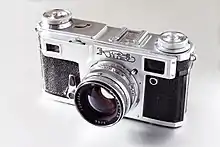
Kiev 4 is the most common of Kiev rangefinders. It had some minor visual modifications to be visually closer to Contax III. There are the versions of this camera, Kiev 4 and Kiev 4A. But in this case both of them have the flash sync capability. The Kiev 4A version lacks the selenium light meter. Because of this, it is usually more desirable than Kiev 4. Light meters on those cameras are usually useless because of selenium light meters becoming inaccurate as they age.
Kiev 4M / Kiev 4AM
Kiev 4M was a modernized version of Kiev 4. It is usually less desirable than Kiev 4 because of very bad quality control on those cameras - but generally, they should be somewhat more pleasant to shoot than their older siblings. Again, there are two versions. The Kiev 4M and the Kiev 4AM, which is the same camera but it lacks the light meter.
With the Kiev-4M, the standard lens was changed from Jupiter-8 to Helios-103. The Helios-103 is generally believed to be a very good lens, usually surpassing Jupiter-8 in reviews.
Kiev 5
There was also a Kiev 5 with a modernized upper part with integrated meter. Its design drifted far away from the Contax base other Kiev rangefinders were built on. It still shared the same lens mount, but the inner bayonet was removed - the camera introduced Helios-94 and Jupiter-8NB lenses which are a 50mm focal length lenses, but they utilize the external bayonet.
Lenses
| Name | Info | Bayonet | Further info |
|---|---|---|---|
| Orion-15 | 28mm f/6.0 | External | |
| Jupiter-12 | 35mm f/2.8 | External | Jupiter (lenses) |
| Jupiter-3 | 50mm f/1.5 | Internal | Jupiter (lenses) |
| Jupiter-8 | 50mm f/2.0 | Internal | Jupiter (lenses) |
| Jupiter-8M | 50mm f/2.0 | Internal | Jupiter (lenses) |
| Jupiter-8NB | 50mm f/2.0 | External | Jupiter (lenses) |
| Helios-94 | 50mm f/1.8 | External | |
| Helios-103 | 53mm f/1.8 | Internal | |
| Jupiter-9 | 85mm f/2.0 | External | Jupiter (lenses) |
| Jupiter-11 | 135mm f/4.0 | External | Jupiter (lenses) |
Kiev 35mm SLRs
Arsenal also made a range of 35 mm SLR cameras. They are not as well known as Zenit cameras, but they are still desirable for some of the innovative features they offer.
Kiev Automat SLRs
The unique Kiev Automat SLRs used their own unique lens mount; only a handful of lenses were available in that format. All these cameras use an unusual fan-shaped shutter. They are collector's items that were not exported.
Kiev 10
Kiev 10 was one of the most innovative cameras produced in the Soviet Union. It was one of the first cameras that offered automatic exposure. It also featured its own lens mount, shared with its successors. The camera had a light meter, but it was a selenium one. Its accuracy declines with age.
Kiev 11
A development of Kiev 10. Only small quantities of this camera were produced. The main difference was that the light meter was moved from the top to the side.
Kiev 15 TEE / Kiev 15 TTL
This camera had two names during its lifespan, but these models were identical. The main difference in this model it was added TTL (Through The Lens) metering. Those meters are accurate even nowadays.
Lenses
| Name | Info | Further info |
|---|---|---|
| Mir-20 | 20mm f/3.5 | Mir (lenses) |
| Mir-1 | 37.5mm f/2.8 | Mir (lenses) |
| Helios-65 | 50mm f/2.0 | |
| Helios-81 | 50mm f/2.0 | |
| Jupiter-9 | 85mm f/2.0 | Jupiter (lenses) |
| Jupiter-11 | 135mm f/4.0 | Jupiter (lenses) |
Kiev F SLRs
The Kiev F line, available since around 1980, constituted some of the most westernized 35mm SLRs available in the days of the Soviet Union. To satisfy the large internal demand, there was no discernible export at the time they would have found a ready market in the West. Instead, the Zenit with an external selenium meter was sold in large numbers. It was Soviet policy to export domestic surplus rather than the more desirable items of their manufacture.
Kiev 17
Kiev 17 was the first in the F line of Kiev SLRs. It was a fully manual camera. It did not even have a light meter. It is said to be a really unreliable camera.
Kiev 18
A rare prototype camera. There's very little known about it.
Kiev 19
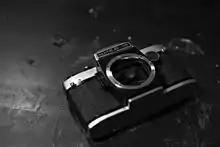
A much better rated successor to Kiev 17. It offers stop-down TTL metering with helper LEDs in the viewfinder. It lacks the top shutter speed of 1/1000s, thus maxing out at 1/500s.
Kiev 20
This camera model adds the aperture coupling and the self-timer to Kiev 19 design. It also readds the 1/1000s top shutter speed.
Kiev 19M
The body type is changed to molded polycarbonate, making it only Kiev SLR not made from metal. Despite its model number, it succeeds the Kiev 20. It has the same 1/500s top shutter speed as the 19, though. This is by far the most produced version of Kiev F SLRs. This model was produced long after Soviet Union fell and was also exported to other countries.
Lenses
| Name | Info | Further info |
|---|---|---|
| Helios-81N | 50mm f/2.0 | |
| Helios-123N | 50mm f/2.0 | |
| Zenitar-N | 16mm f/2.8 | |
| Mir-73N | 20mm f/2.8 | Mir (lenses) |
| Mir-20N | 20mm f/3.5 | Mir (lenses) |
| Kaleinar-5N | 100mm f/2.8 | |
| Granit-11N | 80-200mm f/4.5 | |
| Peleng-N | 8mm f/3.5 | |
| Mir-47N | 20mm f/2.5 | Mir (lenses) |
| Volna-8N | 50mm f/1.2 |
Kiev medium format cameras
The Kiev brand is probably best known for two 6×6 medium format cameras:
Kiev 88
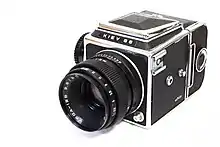
An almost direct clone of the original Hasselblad 1600 F sometimes jokingly referred to as a Hasselbladski.
Originally called "Salyut", it added a self-timer mechanism below the film advance knob to the original Hasselblad design. However, this add-on was abandoned and is seen only on very early or prototype cameras. The Salyut went into mass production around 1957. An automatic aperture mechanism was later added and the camera's designation was changed to "Salyut C". After "Salyut C" the camera model evolved into "Kiev 80". With the further addition of a hot shoe for electronic flashes, the camera's name became "Kiev 88". It was sometimes exported to the West as the "Zenith 80".
The Kiev 88 used a screw-type lens mount similar to the original Hasselblad mount, however, there are mixed reports on compatibility between the two. Most film backs are not compatible between Kievs and Hasselblads due to different gear mechanisms. However, Kiev 88 viewfinders are compatible with the Hasselblad 1600F and 1000F, and even current Hasselblad V-system models.
The Kiev 88 lens mount was modified to accept most Pentacon Six mount lenses around 1999 and designated the Kiev 88CM. Many of these cameras have found their way around the world, especially to the United States. They are considered inexpensive alternatives in the medium film format camera market (see below).
Kiev 60
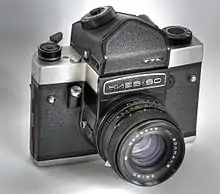
The Kiev 60 is similar to an enlarged 35 mm SLR, based loosely on the Pentacon Six and using the same breech-lock lens mount. This camera was originally called the Kiev 6C with a shutter release button activated by the left hand, and accepting both 220 and 120 film. The current Kiev 60 has a more conventional right-handed shutter release, but does not take 220 film. The Kiev 60 has a simpler frame-advancement mechanism than the Pentacon Six but it is often poorly adjusted at the factory resulting in incorrect frame spacing.[3] This problem can be fixed.[4]
There is both a waist level finder and metered prism finder available. It has no removable film back, thus making the Kiev 60 design simpler and less prone to light leaks, which is sometimes a problem with the Kiev 88 design.
Attractions of Kiev cameras, and problems
The low price of the Kiev medium format cameras has attracted many amateur photographers wishing to enter the medium format camera market on a budget. Some have reported that the prices of a Kiev camera setup with other Russian or Ukrainian components (e.g. lenses) can be 1/10 to 1/15 the price of a similar Hasselblad setup. This being true for comparison with other similar cameras in the 1990s and still for today regarding specifically Hasselblad, the prices of 6x4.5, 6x6 and 6x7 SLR cameras and lenses from more reliable producers like Mamiya, Bronica and Pentax came down to prices comparable or even cheaper as for Kievs beginning by the mid 2000s.
Historically, the Arsenal plant is reported to have generally poor quality control and some buyers have reported receiving cameras with small cosmetic or functional defects. Many of the less favorable reviews come from people comparing the camera directly to the more expensive Hasselblad models. The quality control seems to have fluctuated throughout different years of production though, and thus varies from camera to camera.
For this reason, a number of third party distributors have appeared offering Kiev cameras in safer, quality controlled forms. However, some have taken advantage of the Arsenal plant's variable quality to add value through varying levels of third-party rebuilding, modification, and testing of the Arsenal-supplied cameras.
The cameras, however, still have a number of quirks that no simple servicing will remove. The most notable quirk is that the shutter speed on some of the original Kiev 88 cameras should only be changed after cocking the shutter (spring-loading the shutter mechanism and advancing the film). Changing the shutter speed on an un-cocked camera will damage the timing mechanism.[5] This is not a problem with the Kiev 60 and Kiev 88CM variants. There are also mixed reports that the shutter speed dial should be turned only clock-wise, never anti-clock-wise. This is certainly known to be an issue with cameras modified by Hartblei to add a mirror lock-up (MLU) feature. Other cameras may or may not have this problem.
Common modifications
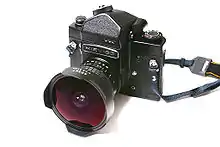
The vendors that sell Kiev cameras outside of the former Soviet Union often make their own modifications to the cheap and basic cameras coming from the factory.
Mirror lock-up is a feature that can be added to the Salyut-C, Kiev-88 and Kiev-60. This removes the small amount of motion blur that can be caused by the mirror hitting the top of the mirror box just before the shutter opens. (Other sources of motion-blur still remain, however). It is most useful when the subject is greatly magnified e.g. using a long or telephoto lens, or doing macro photography.
The Kiev 60 is sometimes modified to shoot with a 6x4.5 frame size, often called "Kiev 645" or similar, yielding more pictures per roll of film in a "print-friendly" rectangular format versus the original camera's square 6x6 format. But since the film feeds sideways, the 6x4.5 variant produces photos in the portrait aspect, as opposed to the landscape aspect seen in most other cameras. The Kiev 88 can shoot the 6x4.5 frame size by simply using a different film back. The 6x4.5 film back is interchangeable with others for 6x6 and other frame sizes, while the Kiev 60 modification is permanent.
Lenses
One of the reasons for the lasting demand for these cameras is the price of the lenses that can be used on them. Despite the cheap price, the Kiev lenses are high quality optic wise, with many of the lenses being based on Zeiss designs. Among the best is the Arsat MC 1:3.5/30 mm fisheye lens, previously known as the "Zodiak 8" in a single-coated version. This lens is reputedly quite good and generally available for under US$250, which is stunning since one would have to spend many thousands of dollars to get a non-Ukrainian equivalent lens of this type.[6]
Medium format lenses produced by Arsenal for Kiev cameras:
| Name | Info | Further info |
|---|---|---|
| Zodiak 8 | 30mm f/3.5 | |
| Mir-26 | 45mm f/3.5 | Mir (lenses) |
| Mir-3 | 65mm f/3.5 | Mir (lenses) |
| Mir-38 | 65mm f/3.5 | Mir (lenses) |
| Volna-3 | 80mm f/2.8 | |
| Vega-12 | 120mm f/2.8 | |
| Kaleinar-3 | 150mm f/2.8 | |
| Jupiter-36 | 250mm f/3.5 | Jupiter (lenses) |
| Telear-5 | 250mm f/5.6 | |
| Tiar-33 | 300mm f/4.5 | |
| ZM-3 | 600mm f/8.0 |
The 1:5.6 and 1:8.0/500 mm Rubinar Catadioptric (mirror) lenses are sometimes adapted to fit on Kiev medium format cameras. Shift and Tilt-Shift lenses based on the 45 mm and 65 mm optics are also available. These lenses allow photographers to take advantage of the Scheimpflug principle for achieving greater apparent depth of field without adjusting the aperture, and gain other controls similar to those found on view cameras.
References
- http://www.ussrphoto.com/Wiki/default.asp?WikiCatID=20&ParentID=1&ContentID=560&Item=Kiev+3+%2F+III+Ukrainian+Logo
- Johnston, Mike (29 November 2009). "ARSENAL Closes its Doors". The Online Photographer. Retrieved 11 March 2010.
- Vartanyan, Gevorg. "Differences between Kiev-60 and Kiev-88" (PDF). ARAX Inc. Retrieved 26 November 2007.
- Hippert, Russell. "How to Re-Calibrate Kiev 60". kievaholic.com. Retrieved 29 July 2009.
- Kalsbeek, Kevin. "Kiev 88 always and never" (PDF). ARAX Inc. Retrieved 26 November 2007.
- TRA. "30mm fish-eye lenses for Pentacon Six – Pt 1". The Pentacon Six System. Retrieved 3 October 2008.
External links
- Kiev60SLR – DIY site for users of the Kiev 60 camera.
- Kievaholic – A "fan" site for Kiev 60 and 88 users with more information.
- Arax upgrade process – An illustrated example of the modifications that one vendor does to a Kiev camera from the factory.
- Kiev rangefinders
- Current product line of Arsenal factory (Russian)
- "Arsenal" State Enterprise Plant
